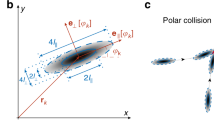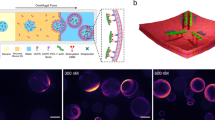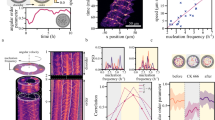Abstract
The emergence of collective motion exhibited by systems ranging from flocks of animals to self-propelled microorganisms to the cytoskeleton is a ubiquitous and fascinating self-organization phenomenon1,2,3,4,5,6,7,8,9,10,11,12. Similarities between these systems, such as the inherent polarity of the constituents, a density-dependent transition to ordered phases or the existence of very large density fluctuations13,14,15,16, suggest universal principles underlying pattern formation. This idea is followed by theoretical models at all levels of description: micro- or mesoscopic models directly map local forces and interactions using only a few, preferably simple, interaction rules12,17,18,19,20,21, and more macroscopic approaches in the hydrodynamic limit rely on the systems’ generic symmetries8,22,23. All these models characteristically have a broad parameter space with a manifold of possible patterns, most of which have not yet been experimentally verified. The complexity of interactions and the limited parameter control of existing experimental systems are major obstacles to our understanding of the underlying ordering principles13. Here we demonstrate the emergence of collective motion in a high-density motility assay that consists of highly concentrated actin filaments propelled by immobilized molecular motors in a planar geometry. Above a critical density, the filaments self-organize to form coherently moving structures with persistent density modulations, such as clusters, swirls and interconnected bands. These polar nematic structures are long lived and can span length scales orders of magnitudes larger than their constituents. Our experimental approach, which offers control of all relevant system parameters, complemented by agent-based simulations, allows backtracking of the assembly and disassembly pathways to the underlying local interactions. We identify weak and local alignment interactions to be essential for the observed formation of patterns and their dynamics. The presented minimal polar-pattern-forming system may thus provide new insight into emerging order in the broad class of active fluids8,23,24 and self-propelled particles17,25.
This is a preview of subscription content, access via your institution
Access options
Subscribe to this journal
Receive 51 print issues and online access
$199.00 per year
only $3.90 per issue
Buy this article
- Purchase on Springer Link
- Instant access to full article PDF
Prices may be subject to local taxes which are calculated during checkout





Similar content being viewed by others
References
Karsenti, E. Self-organization in cell biology: a brief history. Nature Rev. Mol. Cell Biol. 9, 255–262 (2008)
Kruse, K., Joanny, J. F., Julicher, F., Prost, J. & Sekimoto, K. Asters, vortices, and rotating spirals in active gels of polar filaments. Phys. Rev. Lett. 92, 078101 (2004)
Loose, M., Fischer-Friedrich, E., Ries, J., Kruse, K. & Schwille, P. Spatial regulators for bacterial cell division self-organize into surface waves in vitro . Science 320, 789–792 (2008)
Couzin, I. D., Krause, J., Franks, N. R. & Levin, S. A. Effective leadership and decision-making in animal groups on the move. Nature 433, 513–516 (2005)
Dombrowski, C., Cisneros, L., Chatkaew, S., Goldstein, R. E. & Kessler, J. O. Self-concentration and large-scale coherence in bacterial dynamics. Phys. Rev. Lett. 93, 098103 (2004)
Riedel, I. H., Kruse, K. & Howard, J. A. Self-organized vortex array of hydrodynamically entrained sperm cells. Science 309, 300–303 (2005)
Nedelec, F. J., Surrey, T., Maggs, A. C. & Leibler, S. Self-organization of microtubules and motors. Nature 389, 305–308 (1997)
Narayan, V., Ramaswamy, S. & Menon, N. Long-lived giant number fluctuations in a swarming granular nematic. Science 317, 105–108 (2007)
Backouche, F., Haviv, L., Groswasser, D. & Bernheim-Groswasser, A. Active gels: dynamics of patterning and self-organization. Phys. Biol. 3, 264–273 (2006)
Grossman, D., Aranson, I. S. & Ben Jacob, E. Emergence of agent swarm migration and vortex formation through inelastic collisions. New J. Phys. 10, 023036 (2008)
Czirok, A., BenJacob, E., Cohen, I. & Vicsek, T. Formation of complex bacterial colonies via self-generated vortices. Phys. Rev. E 54, 1791–1801 (1996)
Surrey, T., Nedelec, F., Leibler, S. & Karsenti, E. Physical properties determining self-organization of motors and microtubules. Science 292, 1167–1171 (2001)
Toner, J., Tu, Y. H. & Ramaswamy, S. Hydrodynamics and phases of flocks. Ann. Phys. 318, 170–244 (2005)
Baskaran, A. & Marchetti, M. C. Enhanced diffusion and ordering of self-propelled rods. Phys. Rev. Lett. 101, 268101 (2008)
Baskaran, A. & Marchetti, M. C. Hydrodynamics of self-propelled hard rods. Phys. Rev. E 77, 011920 (2008)
Mishra, S., Baskaran, A. & Marchetti, M. C. Fluctuations and pattern formation in self-propelled particles. Phys. Rev. E 81, 061916 (2010)
Vicsek, T., Czirok, A., Benjacob, E., Cohen, I. & Shochet, O. Novel type of phase transition in a system of self-driven particles. Phys. Rev. Lett. 75, 1226–1229 (1995)
Chate, H., Ginelli, F., Gregoire, G. & Raynaud, F. Collective motion of self-propelled particles interacting without cohesion. Phys. Rev. E 77, 046113 (2008)
Ginelli, F., Peruani, F., Bär, M. & Chaté, H. Large-scale collective properties of self-propelled rods. Phys. Rev. Lett. 104, 184502 (2010)
Kraikivski, P., Lipowsky, R. & Kierfeld, J. Enhanced ordering of interacting filaments by molecular motors. Phys. Rev. Lett. 96, 258103 (2006)
Aranson, I. S. & Tsimring, L. S. Pattern formation of microtubules and motors: inelastic interaction of polar rods. Phys. Rev. E 71, 050901 (2005)
Joanny, J. F., Julicher, F., Kruse, K. & Prost, J. Hydrodynamic theory for multi-component active polar gels. New J. Phys. 9, 422 (2007)
Jülicher, F., Kruse, K., Prost, J. & Joanny, J. F. Active behavior of the cytoskeleton. Phys. Rep. 449, 3–28 (2007)
Simha, R. A. & Ramaswamy, S. Hydrodynamic fluctuations and instabilities in ordered suspensions of self-propelled particles. Phys. Rev. Lett. 89, 058101 (2002)
Baskaran, A. & Marchetti, M. C. Statistical mechanics and hydrodynamics of bacterial suspensions. Proc. Natl Acad. Sci. USA 106, 15567–15572 (2009)
Sheetz, M. P., Chasan, R. & Spudich, J. A. ATP-dependent movement of myosin in vitro: characterization of a quantitative assay. J. Cell Biol. 99, 1867–1871 (1984)
Fulga, F. & Nicolau, D. V. Models of protein linear molecular motors for dynamic nanodevices. Integ. Biol. 1, 150–169 (2009)
van den Heuvel, M. G. L. & Dekker, C. Motor proteins at work for nanotechnology. Science 317, 333–336 (2007)
Acknowledgements
We thank A. Baskaran and C. Marchetti for discussions. Financial support from the DFG in the framework of the SFB 863 and the German Excellence Initiatives via the ‘Nano-Initiative Munich (NIM)’ and the Technische Universität München - Institute for Advanced Study is gratefully acknowledged. V.S. and C.W. acknowledge support from the Elite Network of Bavaria by the graduate programmes CompInt and NanoBioTechnology.
Author information
Authors and Affiliations
Contributions
A.R.B., C.S. and V.S. conceived and performed the experiments. C.W. and E.F. conceived and designed the simulations. C.W. performed and analysed the simulations. A.R.B., C.S., V.S., C.W. and E.F. interpreted the data. A.R.B., V.S., C.W. and E.F. wrote the paper.
Corresponding author
Ethics declarations
Competing interests
The authors declare no competing financial interests.
Supplementary information
Supplementary Information
This file contains Supplementary Materials and Methods, Supplementary Figures 1-3 with legends and additional References. (PDF 472 kb)
Supplementary Movie 1
This movie shows a homogeneous cluster moving in a dilute and disordered background right above the critical filament density pc (p = 5.5 uµ-2, labeling ratio 1:200, filament length ~10 µm, 40x objective). (MOV 4191 kb)
Supplementary Movie 2
This movie shows density waves observed at a filament density of pm-2 for two different magnifications (first part: 40x objective, second part: 100x objective). (labeling ratio 1:320, filament length ~10 µm). (MOV 4062 kb)
Supplementary Movie 3
This movie shows swirling pattern and movement of the central region of the swirl (pm-2, labeling ratio 1:320, filament length ~10 µm, 40x objective). (MOV 4356 kb)
Supplementary Movie 4
This movie shows a close up of the central region of a typical swirling pattern (pm-2, labeling ratio 1:320, filament length ~10 µm, 100x objective). (MOV 4864 kb)
Supplementary Movie 5
This movie, which is in 2 parts, shows oscillatory orientational bending of coherently moving filaments (first part) and the gradually developing splay pattern (second part) (pm-2, labeling ratio 1:320, filament length ~10 µm, 100x objective). (MOV 3858 kb)
Supplementary Movie 6
This movie shows the emergence of patterns in the cellular automaton simulations as observed in the entire simulation box with reflective boundary conditions (r = 83%, ς= 10, α = 10, simulation time 0 – 5000, ‘labeling ratio’ 1:40). (MOV 4000 kb)
Supplementary Movie 7
This movie shows a close up on an emergent polar nematic pattern in a region of observation far away from the boundaries (r = 83%, ς= 10, α= 10, simulation time 0 – 5000, ‘labeling ratio’ 1:40). (MOV 3835 kb)
Rights and permissions
About this article
Cite this article
Schaller, V., Weber, C., Semmrich, C. et al. Polar patterns of driven filaments. Nature 467, 73–77 (2010). https://doi.org/10.1038/nature09312
Received:
Accepted:
Issue Date:
DOI: https://doi.org/10.1038/nature09312
This article is cited by
-
Spontaneous shock waves in pulse-stimulated flocks of Quincke rollers
Nature Communications (2023)
-
The crucial role of adhesion in the transmigration of active droplets through interstitial orifices
Nature Communications (2023)
-
Polarity and chirality control of an active fluid by passive nematic defects
Nature Materials (2023)
-
Emergence of synchronised rotations in dense active matter with disorder
Communications Physics (2023)
-
Curvature induces active velocity waves in rotating spherical tissues
Nature Communications (2023)
Comments
By submitting a comment you agree to abide by our Terms and Community Guidelines. If you find something abusive or that does not comply with our terms or guidelines please flag it as inappropriate.



